Chapter Ten

Togetherness
Jen Lemen
“But let there be spaces in your togetherness and let the winds of the heavens dance between you. Love one another but make not a bond of love: let it rather be a moving sea between the shores of your souls.”—Kahlil Gibran
 Her name is Esteria. She lives in a wide, open field in Rwanda in the house her son, Innocent, built for her. Five- and ten-dollar bills came from all over the world after I told the story of going to stay with her, out of a gesture of love to her daughter—my very best friend—who lives in the United States, so far away from her. The first time we met, Esteria welcomed me like a long-lost daughter, the child she never knew. I went to her arms as if I had always belonged there and then sat back to hear the stories—how she had been dreaming of a girl like me for 30 years, how she had been waiting, how relieved she was I brought the lights.
Her name is Esteria. She lives in a wide, open field in Rwanda in the house her son, Innocent, built for her. Five- and ten-dollar bills came from all over the world after I told the story of going to stay with her, out of a gesture of love to her daughter—my very best friend—who lives in the United States, so far away from her. The first time we met, Esteria welcomed me like a long-lost daughter, the child she never knew. I went to her arms as if I had always belonged there and then sat back to hear the stories—how she had been dreaming of a girl like me for 30 years, how she had been waiting, how relieved she was I brought the lights.
On this visit she confessed that the recurring dream was not an easy one—that she had seen a white woman coming into her house with torches, how she feared that the house would go up in flames, how it disturbed her so much she told her two closest sons and her daughter, years before we met. She tells me, only now, that all her dreams had come true, only none of it happened the way she imagined.
The house in her new dream would be a new one to replace the mud shack that was falling apart in the spring rains. The light would be her eyes shining at the thought that she had ever been afraid. The fire would be the love that ignited when we gathered—her children, her grandchildren, and me—all in the same place, all of us equally enchanted by the other. The torches would be a bagful of headlamps that made her laugh and laugh to see the light shining from her head as she made her way across the room that had always been dark, electricity a luxury not yet possible for an old woman in the village.
I ask her what she’s dreaming now as she holds my hand, the one with the gold ring she gave me, the ring that is turning my finger green and making me happy. “Everything will happen in its own time,” she tells me, not willing to give away any more secrets. “Besides, what could we dream that could be any better than this—to be together, body, mind and spirit? What could we imagine that could give us any more comfort? What could possibly give us any more hope?”
This is the photograph I took at the end of the conversation—the one where I leaned over for my camera with one hand, lifted it up to capture the moment in one snap. She knows this now about me, how I can’t resist the urge to record the moments where we are most truly together. Like she always does, she asks if I will bring her a copy when I return to Rwanda—so she can remember it, too, when the only way we can be in the same place is in a small glossy picture she holds in her hand, the same way I hold the memory of her in my heart.
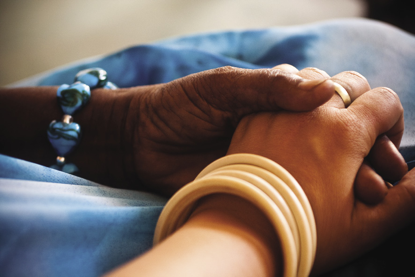
Introduction
The desire to capture and chronicle our moments of being together can transform even the most casual photographer into the keeper of memories family and friends cherish for years to come. We begin with holidays, vacations, and other occasions that draw us all to the same place at the same time. We insist that everyone crowd in, put their faces together and smile for the camera, so we will have some record that we were all there in the same moment at the same time. Our togetherness extends to everyday interactions with the people we value most—the piggyback ride in the backyard, the shared bliss of the summer sun, the stolen kiss, the sweetness of having a companion when we feel most alive or even most alone. These portraits of togetherness nourish our souls long after the moment fades. They are our record of how we loved, keeping us together in spirit—even as life sometimes demands that we be apart.
The key to photographing togetherness is an eye turned on all the ways our hearts and minds connect. These connections exist all around us and can be revealed, and explored at any given moment. Like a detective looking for clues to solve a mystery, the curious photographer collects evidence that proves we are closer than we think. Sometimes the proof is obvious—a spontaneous kiss or a passionate embrace. But more often the signs are subtle—an extended hand, a backward glance, or a body leaning in with interest.
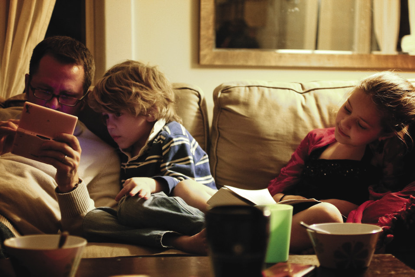
The Comfort of Home
You can discover togetherness wherever people come together by using your camera like a periscope, observing from deep below the surface, looking for signs of connection or grace. From this thoughtful orientation, even the most simple shot can capture a depth of togetherness that you and your subjects will cherish forever.
Shutter Sisters’ Blog, by Stephanie
 Photo shoots” are a strange concept when you think about it. People invite strangers with cameras into their homes, hoping they’ll be able to capture and solidify a bit of what they feel for each other. We all know inherently that our dearest moments are fleeting. And so we expose ourselves. Because it’s worth it. Because if it works, we’re left with pieces of actual paper, pictures that feel permanent, and that depict and prove our most sacred connections. Our minutes, which were once evaporating, now feel solidly tangible. As photographers, we know this is the expectation. We know people want us to fish out all the real bits of their lives. We love what we do and we want to do a good job. And if we’re not careful we can become on a mission about it. And that’s when the magic bleeds right out of your work. Because finding moments is like chasing a rainbow. The second you feel like you know how to get there is the second it disappears. That’s what keeps it adventurous: the idea that some things cannot ever be planned or plotted. They can only be waited for and revered.
Photo shoots” are a strange concept when you think about it. People invite strangers with cameras into their homes, hoping they’ll be able to capture and solidify a bit of what they feel for each other. We all know inherently that our dearest moments are fleeting. And so we expose ourselves. Because it’s worth it. Because if it works, we’re left with pieces of actual paper, pictures that feel permanent, and that depict and prove our most sacred connections. Our minutes, which were once evaporating, now feel solidly tangible. As photographers, we know this is the expectation. We know people want us to fish out all the real bits of their lives. We love what we do and we want to do a good job. And if we’re not careful we can become on a mission about it. And that’s when the magic bleeds right out of your work. Because finding moments is like chasing a rainbow. The second you feel like you know how to get there is the second it disappears. That’s what keeps it adventurous: the idea that some things cannot ever be planned or plotted. They can only be waited for and revered.
Approach
Images that demonstrate a sense of togetherness can be obvious or subtle, simple or complicated. All that matters is the connection.
Catching people in a moment of honest connection requires a certain kind of seeing. And making sure that interaction makes it into your viewfinder is another challenge in and of itself. More often than not photographers will tell you that the most poignant moments of togetherness usually come in those off-script moments, long after you have carefully placed your subjects together where everyone was lined up just so. By allowing yourself the freedom to move in and out of a scene, you can turn your attention to mood, light, composition, storytelling and gesture—key elements in creating images that reflect the relationships already present in the room.

Woman and Kids on Brown Couch, by Stephanie
Having the right lens for the occasion and deciding where to stand ensures you’ll be ready when the scene unfolds before you. Stephanie’s super wide-angle lens was the perfect choice for this small dark room in Kigali, Rwanda. By standing quietly against the wall, Stephanie was able to capture the shot without disturbing the tenderness of the moment. In addition, her lens was wide enough to reveal a stark bare room, highlighting the intimacy of the conversation on the couch and the subjects’ physical proximity.
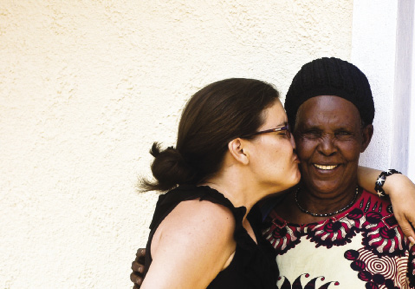
Impromptu Smooch, by Lilian Bizuru
You can mastermind your best togetherness shots by relinquishing your right as a photographer to place everyone in the frame, and ask for permission instead to shoot without explanation as events unfold.
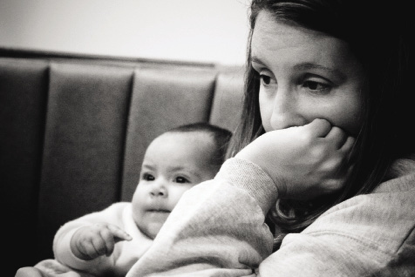
The Weight of Truth
Not every image of togetherness needs to be cheerful to capture the relationship between your subjects. This photograph reveals both the heavy-heartedness of the mother and the companionship of the child. By turning your lens on the truth of a situation, even if circumstances are challenging, you provide a record of the way we hold onto one another when hope feels elusive and life demands too much. You can honor the full spectrum of the human experience when you approach all the facets of being together—even in those moments when we feel disconnected and alone.
Perspective
As you revere the relationship of your subjects, choose a perspective that highlights both the visible connection and the emotion that lies behind it, just out of sight.
Have you ever looked at a photograph and realized something about a person or a relationship by what you saw there? Some instances of togetherness are uniquely revealed by the photographer’s point of view. Your ability to look through the lens and find what is unsaid will speak volumes about the emotions your subjects share. Where you stand and what you choose to see can create as well as reveal a sense of connection that isn’t easy to get at first glance.
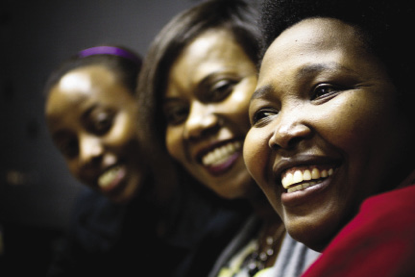
Expression of Friendship
Shooting in a line directly to your side is a simple way to capture the intimacy of your subjects from a new perspective. The beauty of this point of view is you can catch a variety of expressions amongst the group without insisting that everyone look your way. This method might also allow you to capture your subjects off the cuff in a more natural situation, free to express their true emotion. Plus it brings an unique and unexpected perspective that transcends the traditional approach to point-and-shoot snapshots.
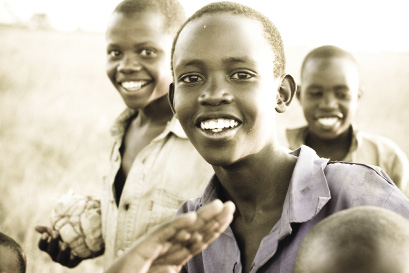
Boyish Charm
Sometimes you can communicate the most by standing right in the middle of the action. It’s hard to avoid the joy and fearless nature of these boys in a field in Rwanda. Their relaxed and happy expressions, and willingness to look straight into the camera offers an intimate perspective on the ease they shared. I simply stood in the middle of their circle and shot whoever popped into the frame first. Processing these images in muted tones accentuated their expressions and minimized the dinginess of their clothes—a factor that may have drawn attention away from the more important subject, which is the bond the boys share.
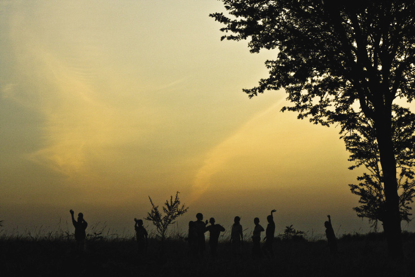
Joy in Silhouette
This image captures the same boys, but this time at a distance of about 100 yards. Notice how distance creates a new perspective on the emotion they share. From this vantage point you can see their innocence and the universal, exuberant nature of their play. This could be any field in any country—but the viewer immediately recalls the joyful, carefree nature of childhood.
See It!
The evening sky creates a perfect backdrop for the silhouettes of the young subjects. The light allows the viewer to take in the full range of their motion, while the dark tree and tall grasses offer perspective on how small the boys are in the expansive field. This perspective also reveals how many boys are playing and the ease with which they interact.
Shoot It!
Try your hand at using silhouettes or shadows of your subjects to tell a story. The challenge is to find the gesture that symbolizes the emotion at hand. It’s one more way to capture an emotional connection without using facial expressions.
Composition
The composition of subjects interacting might seem tricky, but allowing your subjects to naturally relate to one another often leads to an intuitive and poetic cohesion.
Composition creates the perfect conditions for the deepest transfer of emotional expression in a photograph. A simple gesture, a well-framed scene—these are the hallmarks of composition and the way the photographer examines the power of human connection. Whether you find the scene waiting for you or create it yourself, your take on composition can honor the togetherness your subjects share.
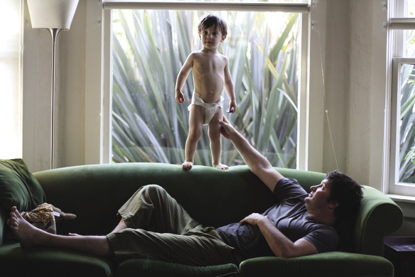
Superhero, by Andrea
Ordinary shots from uneventful days can communicate everything you ever needed to know about the relationship between subjects.
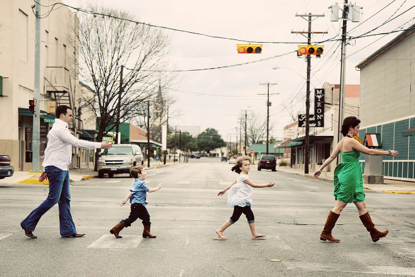
A Stroll down Abbey Road, by Maile
On the contrary, one might choose to formally arrange the subjects in order to reveal the playful nature of their bond. In this scene, Maile recreates the famous The Beatles’ Abbey Road album cover with this family of four. The result is a joyful commentary on their togetherness and enduring bond. By deliberately recreating an iconic scene, Maile invokes humor and brings lighthearted fun to one moment in this family’s cherished history.
Shoot It!
Imitation is the ultimate form of flattery. Find an image or pose you’d like to recreate in your own photography. Remember that togetherness doesn’t have to come through physical contact. The reinterpretation of the Abbey Road album cover shot shows connection and solidarity in a playful way.
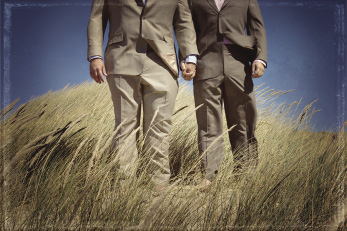
Wedding Day, by Andrea
Sometimes the most straightforward arrangement of people creates the most powerful commentary. In this shot, two young men about to be married stood together in this traditional lineup and then asked for their portrait to be taken. The result is a capture that accentuates the strength of the family ties and the timeless nature of their commitment to one another.
Shoot It!
Experiment with allowing your subjects to compose their own shots. How would they like to stand? Where would they like to be seen together? This small gesture acknowledges that the group being photographed plays a role in revealing the togetherness they share.
Lighting
The light used to illuminate two or more people can add to the emotion of the relationship(s)—be it drama, ease, discord or tenderness. use the light to intensify these feelings.
Lighting plays an important role in establishing the emotional mood of the togetherness through the frame. Whether you choose natural light or take the artful assistance of the flash, your take on lighting will convey warmth, depth, intensity, or repose. Let the light reveal something important about the images you create. The golden hour—the first and last hour of sunlight during the day—is an ideal time to capture togetherness through your viewfinder.
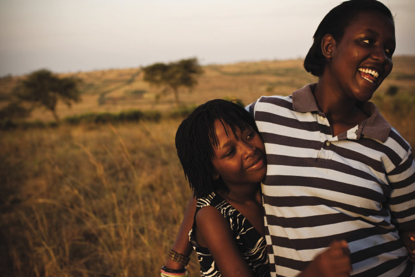
The Warmth of Sisterhood
The sun was just about to set behind me as I photographed these two young girls in a wide open field in Rwanda. The presence of warm natural light minimized the contrast between the skin tones of the girls and the pale grasses amongst which they were standing, creating a warm inviting tone to the image. This same field, nestled in a wide open savannah, is punishing in its harsh sunlight during the day, but by late afternoon there’s no better place to shoot. I’ve learned to keep an eye on my ISO and shoot with as much natural light as possible at the optimal time of day.

Little Sister, by Tracey
Because shooting in the context of home will often evoke the truest tenderness between your subjects, finding the right light at the right moment can be challenging. In the case of Tracey’s shot of her daughters, a nearby window casts a sidelight that is both soft and dramatic, adding to the overall emotion of this affectionate gesture between sisters. You might have to pull back the curtains and dial up your ISO to get the proper exposure, but when you’re looking to capture relaxed and meaningful connections between your subjects, it’s worth every effort.
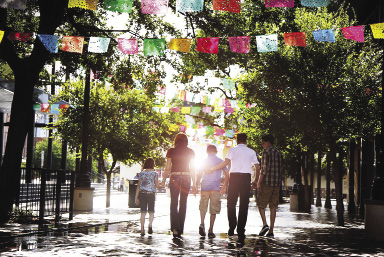
Toward Sun, by Maile
Who says shooting into the sun is a bad idea when it comes to gathering up love in your lens? You can’t help but feel hopeful when watching this family walk straight towards the light. Maile uses the sun as a focal point to create an image where anything feels possible and the connection between people becomes something to honor and celebrate. The flags take on a brighter hue as well, as the direct sunlight illuminates everything of color in this image.
Details
Focusing your attention on the little nuances between people can help dictate what needs to be said in your image. Let your subjects be your guide.
It is the job of the photographer to see the things that others often miss: the subtleties of expression, gesture, body language, the seen points of togetherness and those that are only inferred. It takes more than just a keen eye. It takes a lot of heart and the willingness to dig deeper and feel your subjects. Being willing to read between the lines will elevate your imagery and capture compelling pictures of your subjects.
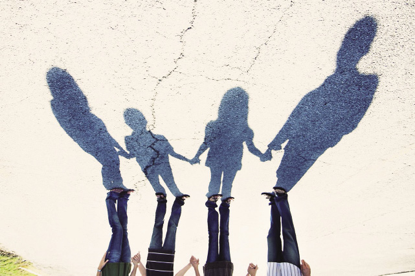
One Family Connected, by Maile
There are infinite ways to capture connection through your lens. Focusing on the details, however, helps to tell specific stories of your subjects. Even the unexpected details can be effective, as Maile’s shadow family proves.
Set It!
ISO: 250
Exposure: 1/1000 sec
Aperture: 2.8
Focal Length: 17mm
Flash Used: No
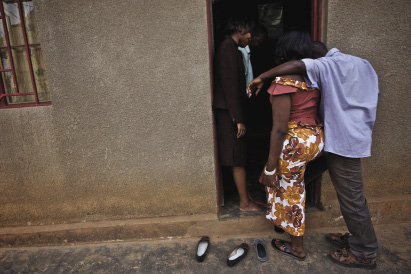
Turikumwe (We are Together), by Stephanie
The details of a relationship may seem intangible, but if you’re seeking the magic between two people, these connections will make themselves clear to you. In shooting a photograph of the same couple, Stephanie takes an important step back to give us another point of view—a look into their relationship. From this vantage point, we notice the man’s arm draped comfortably against the young woman’s shoulder as they move into the house together. You can see the togetherness between the subjects in both images, but from two different perspectives.
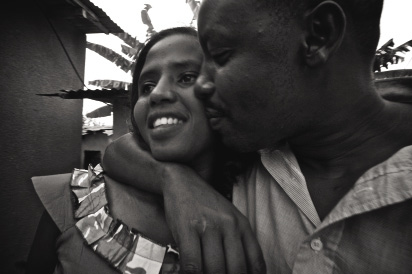
A Love That's True, by Stephanie
In this shot, Stephanie captures an intimate moment by standing in so close to her subjects that we can feel the tightness of his embrace and the affection of his kiss. This intimate perspective allows us to get a front-row seat for this love story. The kiss is the most obvious of affections, after all, but it never gets old.
Shutter Sisters’ Blog, by Stephanie
 I’ve always been a hands person. Thinking about any friend I have, I can very clearly conjure up an image of their hands. Some are strong and look like they could do many hours of work in the hot sun, while others are more delicate and gentle, with long fingers and painted nails. One friend of mine has so many lines crisscrossing all over her hands that I know she surely is an old soul. And then there are Ben’s toddler hands, like little starfish exploring the world. I am moved by how much hands can say in a photograph, how much love can be transmitted by a gentle squeeze, and how much they can hold. There is a Rumi quote I love: “Look at your eyes. They are small, but they see enormous things.” I think the same goes for hands. They are small, but they hold enormous things.
I’ve always been a hands person. Thinking about any friend I have, I can very clearly conjure up an image of their hands. Some are strong and look like they could do many hours of work in the hot sun, while others are more delicate and gentle, with long fingers and painted nails. One friend of mine has so many lines crisscrossing all over her hands that I know she surely is an old soul. And then there are Ben’s toddler hands, like little starfish exploring the world. I am moved by how much hands can say in a photograph, how much love can be transmitted by a gentle squeeze, and how much they can hold. There is a Rumi quote I love: “Look at your eyes. They are small, but they see enormous things.” I think the same goes for hands. They are small, but they hold enormous things.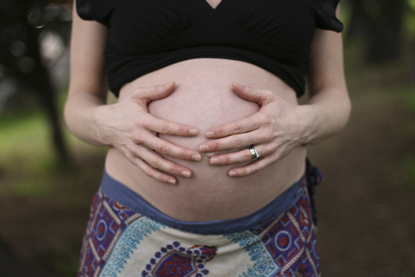
Processing
The ability to either lighten the mood or intensify it is available in the digital darkroom. Emotion can be bolstered and meaning enhanced with even slight edits.
Digital processing is a powerful tool for redirecting the viewer’s focus and highlighting an aspect of togetherness that might otherwise be overlooked. Modern moments can appear timeless when brought into black and white. Vignetting can intensify the heart of the shot. Emphasizing grain or soft focus can create a haze of nostalgia. Don’t be afraid to put your own editorial spin on the connections you observe through the lens by playing with processing.

When Joy Overflows, by Sarah
This indoor nighttime shot brilliantly captures the pure pleasure of the subjects enjoying an evening to remember. Through desaturation of the often overly yellow color of ambient lamplight, Sarah chose a warm-tone monochromatic palette instead to help better tell this story of intimacy among friends. The city lights in the background offer lovely depth and texture, and a magical backdrop of bokeh.
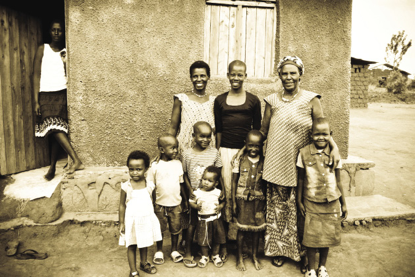
Timelessness of Together
This recent photograph took on a very different feel when processed in sepia tones. The sepia took this family outside of time and echoed long generations of the kind of togetherness we recognize in post-modern times as a tribe. Tweaking the contrast also gave the girl at the door a more prominent presence in the photograph and minimized the background, leaving the impression that this photograph could have been taken at any time, in any era across the African continent.
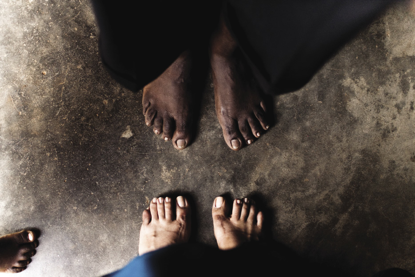
Feet to Feet
My favorite subjects in Rwanda know how much I like to photograph feet. This photograph, shot off the cuff after everyone in the room had their feet photographed, turned out to be the real treasure in the digital darkroom. By lightening the corners in a reverse vignette, the concrete floor takes on the curvature of the earth and bumping up the contrast reveals that the man’s feet are solid on the ground, while mine appear to be floating. The child’s foot in the corner, now more pronounced with the added contrast, adds to the intimacy of the trio and the togetherness we continue to share.
Shoot It!
Vignettes are a commonly used technique that can help draw attention to the subject usually in the center of the frame. Using the reverse vignette—lighter instead of darker around the edges—can create a totally unique and pleasing effect.
Glossary
Aperture The opening of the camera through which light passes. Its setting is measured in ƒ-stops and determines the size of the opening. The size of the opening, depending on the focal length of the lens, impacts the area of focus and the amount of light passing through the camera. The higher the ƒ-stop setting (for example, ƒ/16, ƒ/22), the narrower the opening, resulting in less light and more of the image appearing in focus. The lower the ƒ-stop setting (for example, ƒ/1.4, ƒ/2.8), the wider the opening, resulting in more light and a narrower area of focus, blurring more of the image.
Backlight Illumination of a subject from behind. Backlighting helps separate the subject from its background, often producing a halo-like glow around a subject when enough foreground light is present. When the backlight is significantly more intense than the foreground light, the subject will appear as a silhouette.
Bokeh The blur in the out-of-focus area (the area outside the depth of field) of an image. A shallow focus (i.e. using a wider aperture setting) will create an image with more prominent out-of-focus areas. A deep focus (i.e. using a narrower aperture setting) will create an image with minimal out-of-focus areas. Use bokeh behind your subject in focus to set it apart from the background. This can be particularly effective for portraits. Use bokeh to suggest background elements without showing too much detail in documentary images, or to lend a more abstract, soft or dreamy feel to your image.
Composition The placement or arrangement of visual elements in the viewfinder or in an image.
Contrast The difference between an image’s lightest and darkest tones. In a low-contrast image, colors or tones blend more gradually showing minimal difference between highlights and shadows. In a high-contrast image, colors and tones are differentiated more abruptly, showing a more prominent difference between highlights and shadows.
Depth of field The portion of an image that appears sharp. A large depth of field or deep focus places the entire scene in focus by using a narrow aperture setting (for example, ƒ/16, ƒ/22). A shallow depth of field emphasizes the subject and de-emphasizes the background, with a wide aperture setting (for example, ƒ/1.4, ƒ/2.8).
Diptych Two images intended to be displayed together.
DSLR (digital single-lens reflex camera) A digital camera that uses a mechanical mirror system and a pentaprism (a five-sided prism used to channel a beam of light by 90 degrees) to direct light from the lens to a viewfinder on the back of the camera. You can use a wide variety of interchangeable lenses varying in focal length with a DSLR, giving you the broadest range of creative control for image making.
Exposure The amount of light used to create an image. An overexposed image is created with excessive light, resulting in loss of detail, a washed-out appearance, and blown-out highlights (solid white areas). An underexposed image is created with minimal light, resulting in a dark image with excessive shadows. Also refers to the cycle of a single shutter—for example, a long exposure refers to a single extended or slow-shutter cycle used to capture a low-light scene. Exposure can be adjusted as you shoot, or in post processing using common image processing applications.
External flash An external mount strobe flash attachment for a DSLR. The quality of light emitted from an external flash unit is usually more effective and typically warmer and softer than the camera’s built-in flash. An external flash can be used in low-light conditions to avoid the necessity of using higher ISO settings that could impact the quality of the image or in bright, high-contrast light to fill in any harsh, unavoidable shadows that the sun might cast on your subject(s) with added light (a technique called “fill flash”).
ƒ-stop A measurement that expresses the diameter of an aperture. Measured in one-stop increments (i.e., ƒ/1.4, ƒ/2, ƒ/2.8, ƒ/4, ƒ/5.6, ƒ/8, etc.), each aperture setting has half the light-gathering area of the previous one as the ƒ-stop number increases. The physical size of the aperture will depend on the focal length of the lens.
ISO A setting that determines how sensitive the image sensor is to light. It is the digital equivalent of film speed. A lower ISO setting (i.e. 200) or slow speed is used for bright light conditions and ideal image quality. A higher ISO setting (i.e. 1600) or high speed is used for low-light conditions. The higher the ISO setting, the more “noise,” or grain, will appear in the image.
Lens flare A visual effect (polygonal shapes, bright streaks, or an overall washed-out look) created when very bright light (often emitted from the sun) enters the lens and hits the camera’s digital sensor.
Macro Close up. A macro photograph shows sharp details at a close focal distance.
Monochrome Shades of black and white, or shades of a single color. Color images can be converted to monochrome (or black and white) with most image-processing applications.
Negative space The space around and between the subject(s) of an image. The use of negative space, as a balance to the subject(s), gives the viewer’s eye a place to rest and is an important element of the overall composition of an image.
Perspective The way in which objects appear to the eye based on their spatial attributes. Refers to the photographer’s position and chosen depth of field relative to the composition.
Processing A method of editing and printing digital images in a variety of creative ways that might include one or more of the following: cropping, making adjustments to exposure, contrast, saturation, definition, sharpness, or white balance, or applying vignettes, filters, or textures to images. Often referred to as “post processing” because it is a manipulation of the image done after the photographer shoots and uploads the digital file to the computer.
Saturation The intensity of color. A saturated color is vivid, while a less saturated color is more muted or closer to gray. Saturation can be adjusted with most image-processing applications.
Shutter speed The amount of time the shutter is open (measured in seconds), exposing the image sensor to light through the aperture. Slow shutter speeds are used in low-light conditions, extending the time until the shutter closes, and increasing the amount of light gathered. Fast shutter speeds are used in bright-light conditions, decreasing the time until the shutter closes, and decreasing the amount of light gathered. Shutter speed is adjusted in association with the aperture setting to determine image exposure.
Viewfinder The component of the camera that the photographer looks through to compose, and in most cases to focus, the image.
Vignette A visual effect showing loss of clarity (i.e. blurring or darkening) toward the outer edges of an image. This processing technique lures the viewer’s eye toward the center of the image. A vignette can be applied using most image-processing applications.
White balance Refers to the temperature of white light (warmth vs. coolness). White balance can be adjusted before you shoot using the white balance settings that most DSLR cameras offer or it can be corrected after the fact in most image-processing applications.
Acknowledgments
Without the love and support of our families, friends, and the stellar community of creative women at the Shutter Sisters’ blog, this book could have never come to fruition. We cannot thank all of you enough.
Thank you to Adam Juniper for recognizing the perfect pairing of Shutter Sisters and a book on expressive photography, and for acting on it. Thank you to Natalia Price-Cabrera for her commitment and hard work. And a very special thanks to editor extraordinaire Carey Jones for every single edit, suggestion, and encouraging word. Her involvement throughout this entire process has been invaluable.
This book is dedicated to Shutter Sisters everywhere.